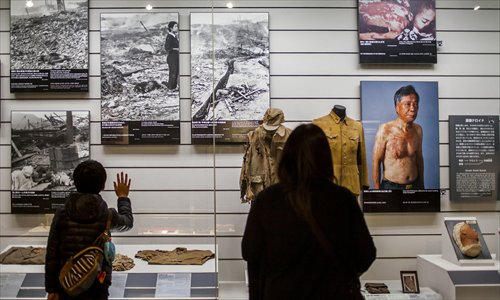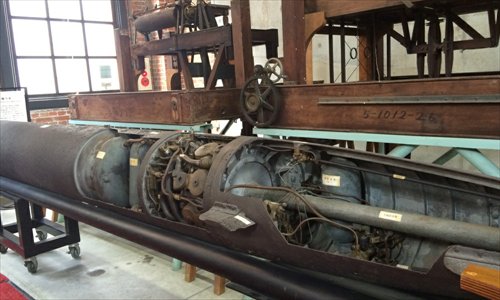HOME >> WORLD
Nagasaki Shipyard’s UNESCO status marred by forced labor
By Catherine Wong Tsoi-lai Source:Global Times Published: 2015-8-6 20:23:01

An exhibition at the Atomic Bomb Museum in Nagasaki Photo: IC

A cutaway model of a torpedo at the Mitsubishi Heavy Industries Ltd. (MHI) shipyard Photo: Catherine Wong Tsoi-lai/GT
Two weeks before the memorial to mark the 70th anniversary of the atomic bombings in Japan, the people of Nagasaki went on as usual in the quiet and peaceful town that once served as a military base during World War II.
Japan's westernmost major city, Nagasaki is primarily known by most of the world as the second target after Hiroshima to be devastated by an atomic bomb in 1945. But Nagasaki has recently entered the spotlight once again for its newly-acquired UNESCO world heritage status.
The Mitsubishi Heavy Industries Ltd. shipyard in Nagasaki is one of the about two dozens of industrial sites being listed by UNESCO. But beyond this distinction, the shipyard is remembered by many as the place where Chinese and Koreans were forced into slavery before and during World War II.
Traces of the brutal war seven decades earlier are no longer visible in Nagasaki's city center. Where there was once rubble and debris of destroyed homes, new hotels stand. The mass production of warships and weaponry has been replaced by small but vibrant shopping centers, where young girls dressed in colorful yukatas, a kind of traditional summer dress, often meet.
These young people had not experienced Nagasaki's wartime past.
In early July, about two dozens sites in Japan, including the Mitsubishi Heavy Industries' Nagasaki Shipyard, were listed as UNESCO world heritage sites. The bid, according to the Japanese government, aimed to highlight the country's Industrial Revolution during the 19th century.
When Global Times visited the city, posters and signs celebrating the city's world heritage status were visible everywhere, from the airport to bus stations.
"The purpose of this exhibition is to tell the world the role that the Nagasaki Shipyard played in the modernization of Japan," said a guide in the history museum inside the shipyard.
Inside the red brick building, over 900 different items were on display. Exhibited photos and machinery told the history of the shipyard, from its opening in 1857 to the manufacturing of battleships, aircraft carriers and torpedoes during World War II.
The exhibits and videos celebrated the shipyard as the world's most advanced manufacturing base at the time.
What was not mentioned, however, was its history of forcing prisoners from neighboring China and Korea into slave labor.
This absence stands in contrast to the history told in the Nagasaki Atomic Bomb Museum. Besides detailing the suffering of innocent Japanese during and after the attack, the museum also details Japan's Fascist past and invasion of China, as well as calls for global denuclearization.
Fault lines
Besides its heritage status, the shipyard also became a focus of attention after Mitsubishi sought to reach a settlement with its past victims of forced labor.
In late July, Kyodo News reported that Mitsubishi planned to issue a public apology and compensate 2 million yen ($16,000) to each of the 3,765 Chinese forced labors or their families.
This came after the company's unprecedented apology to US prisoners of war it had once used as forced labor.
The potential settlement, however, has led to split opinions among different representative groups.
Wang Hongjie, a representative and grandson of a deceased forced laborer, said that despite not being entirely satisfied with the conditions, he would accept the settlement considering that many of the victims are of old age.
"Five or ten years from now, these victims may have all passed away. Even if compensation increases, they may not be able to see the day," said Wang.
Deng Jianguo, a lawyer representing another group of about 500 victims, doubted that the settlement reflects Mitsubishi's sincerity and maintained that they would continue to push for more compensation in Chinese courts.
Japanese scholars believe that resolving the issue of forced labor could help ease bilateral ties.
"Since the normalization of Sino-Japanese relations in 1972, many in Japan have argued that the historical problems between the two countries are resolved," Haruki Wada, historian and professor emeritus at the University of Tokyo. "However, I believe the issue of forced labor, along with that of comfort women, are among the most important issues that need to be addressed," he said.
Hu Lingyuan, professor with the Center for Japanese Studies at Fudan University in Shanghai, said the move reflects that the responsibilities of the Japanese government should be separated from those of the private sector.
"Mitsubishi should take corporate responsibility for the role it played during the war as a military manufacturer," Hu told the Global Times.
"The efforts of individual claimants continued after the 1972 consensus, but they weren't very successful until recent years. We have seen significant progress with this new development. More victims will stand up for their rights," he said.
Newspaper headline: Harboring a dark past
Posted in: Asia-Pacific